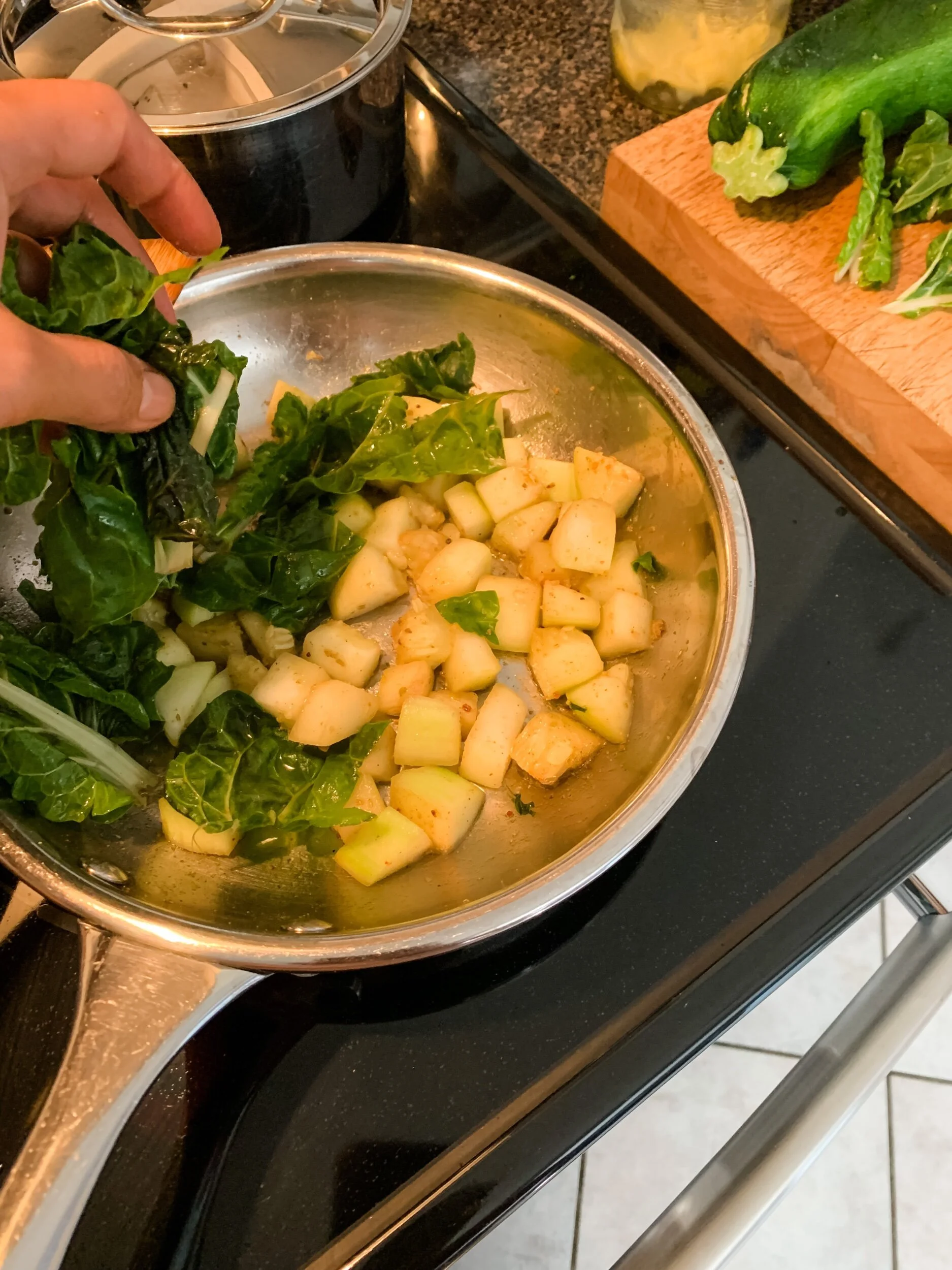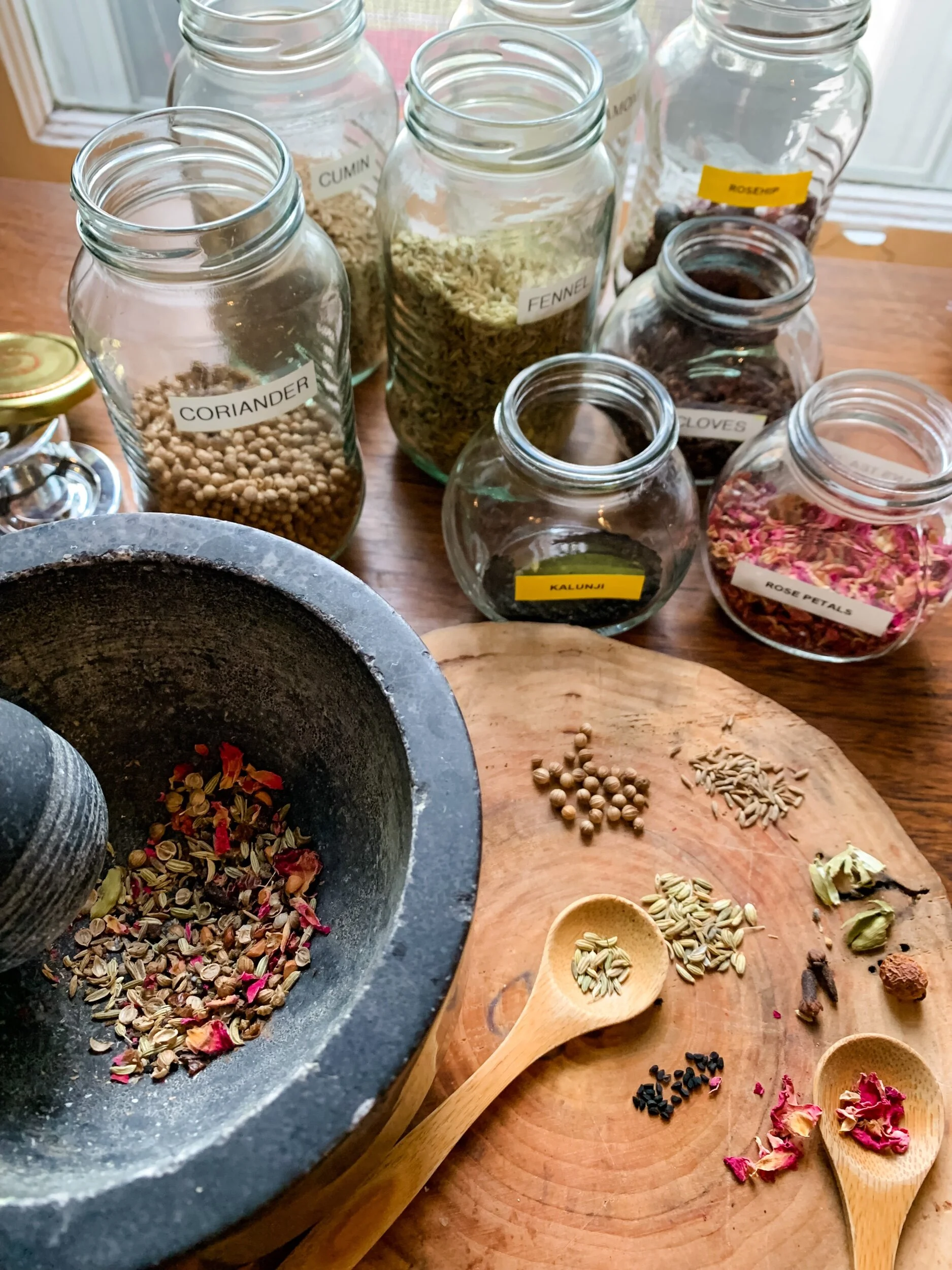Summer Ease: Cooling Spices for Balance & Digestion
Hi and welcome! I’m Evangeline—mom, Registered Massage Therapist, Yoga teacher, and lover of all things health and wellness. I started this blog back in the early days of Covid19 as a way to stay in touch with my clients, and it’s grown into a space to share what I love most. Here you’ll find simple, nourishing recipes I make for my family, sprinkled with Ayurveda and Yoga wisdom. My hope is that these posts inspire you to care for yourself in small, joyful ways and feel a little more balanced in everyday life.
Even as the sun sets, summer’s warmth lingers—and so does the fiery energy it awakens within us. In Ayurveda, this inner fire is known as pitta dosha, the force behind digestion, transformation, and intensity. When balanced, pitta gives us clarity, courage, and vitality. But when overheated—especially in summer—it can lead to irritability, inflammation, and burnout.
Staying cool—both physically and emotionally—is especially important during the summer months. By embracing mindful nourishment, calming daily routines, cooling herbs and spices, and soothing home environments, we can gently pacify the excess internal heat that tends to accumulate this time of year. These small but thoughtful choices help us return to a natural state of balance, clarity, and ease. Start by preparing this simple summer spice mix, and explore the tips that follow to support your well-being all season long.
Summer Spice Mix
3 tsps fennel seeds
3 tsps coriander seeds
½ tsp cardamom seeds (about 6 cardamom pods)
4 cloves
¼ tsp cumin seeds
⅛ tsp kalunji seeds
1 small rosehip
½ tsp rose petals
Grind all together. Store in a glass jar away from heat and sunlight.
How to Use the Summer Spice Mix
If you're new to using whole spices, start with a small amount and gradually increase to suit your taste.
Lightly toast the spice blend in a dry pan to awaken the flavors. Then, add a spoonful of ghee or olive oil and gently sauté until the aroma is released. Toss in your choice of a light protein, then add some zucchini or lauki squash, as with the previous suggestion. Finish with leafy greens for a nourishing, balanced dish.
These mindful cooking practices not only support digestion but bring grounding and joy to your daily meals.
Enjoy!
Ayurvedic Profile of Spices in the Summer Spice Mix
Coriander- cooling, binds toxins and ushers them to the urinary channels
Cumin- opens the agni within the stomach, enhances absorption
Cardamom- cooling quality; helps with protein metabolism
Rosehip- pacifies sadhaka pitta and opens the heart lotus
Cloves- opens up the channels without aggravating pitta dosha
Turmeric- “friend to the liver”, anti-inflammatory, antioxidant, anti-bacterial, anti-viral
Rose petals- pacifies sadhaka pitta; cooling to the body, and soothes the heart and mind
Kalunji- helps balance hormones, enhances absorption
Fennel- cooling, balances the heat of pitta dosha
_________
Read further for a deeper understanding of pitta dosha and more diet and lifestyle tips.
Understanding & Balancing Your Pitta Dosha
Your fiery energy is known in Ayurveda as pitta dosha—the force responsible for digestion, metabolism, and transformation of everything that moves through your body.
Pitta is made up of five sub-doshas, each governing specific functions and located in different parts of the body:
Pachaka Pitta – the stomach, governs digestion
Ranjaka Pitta – the liver, seat of digestion, major detox organ, cleans the blood, digests fats
Sadhaka Pitta – the heart, linked to emotions and intelligence
Alochaka Pitta – the eyes, governs vision
Bhrajaka Pitta – the skin, regulates complexion and temperature
Why Lunchtime Matters for Pitta Dosha
Interestingly, 10 am to 2 pm is also governed by pitta, but during the day this energy supports healthy digestion and mental clarity. Midday or 12pm is when your digestive fire (agni) peaks, making it the ideal time to eat your main meal. Skipping or delaying meals—especially for those with strong pitta or prone to headaches or migraines, and other pitta imbalances—can lead to other health complications. The liver, a key pitta organ, secretes digestive juices in anticipation of food. When no food is present, this can lead to increased acidity, irritability, and “hot blood”, triggers of chronic inflammation.
The Cost of Staying Up Late
Summer evenings can feel magical, but staying up past 10 p.m. may aggravate pitta dosha. In Ayurveda, the hours between 10 p.m. and 2 a.m. are governed by pitta dosha—when the body naturally turns inward for detoxification, digestion of the day’s experiences, and cellular repair. This is a time meant for deep rest. When we stay awake during these hours, especially under artificial light and stimulation from technology use, we disrupt the body’s natural rhythms—overstimulating the liver, mind, and metabolic processes.
The liver, known as the seat of digestion in Ayurveda, plays a vital role in filtering toxins, regulating metabolism, and maintaining emotional equilibrium. And since digestion is viewed as the root of health—or disease, caring for the liver is essential for overall long-term health.
Over time, this habit can lead to a build-up of internal heat and deeper imbalances. Signs may include irritability, overheating, poor digestion, skin and eye discomfort, and eventually more chronic issues such as ulcers, inflammatory conditions, or autoimmune disorders. Honouring the body’s natural cycles by winding down before 10 p.m. allows the body to fully restore, repair and detoxify, supporting long-term vitality and mental-emotional clarity.
Simple Ways to Balance Pitta Dosha
Pitta governs heat, digestion, and transformation—so when it goes out of balance, it can lead to irritability, overheating and chronic inflammation. Here are some simple practices to help restore harmony, especially during the summer months:
DAILY HABITS
Eat at regular times, with your largest meal around midday, when digestive fire is strongest.
Avoid skipping or delaying meals, especially if you tend to overheat or get irritable easily.
Include cooling foods, spices, herbs— lauki squash, zucchini, leafy greens, pears, apples, pomegranates, peaches, plums, apricots, blueberries, grapes, figs; spices and herbs such coriander, fennel, mint, dill, parsley, rosemary, reships, rosebuds
Limit spicy, salty, and overly dry foods, which can stir up internal heat.
Wear cooling gemstones like pearls or rose quartz to soothe and support emotional balance. In Ayurveda, these stones carry lunar energy, and promote a sense of peace and groundedness.
Plenty of indoor plants in your home create a soothing, calm, relaxed feel helping ground and stabilize moods and emotions.
Take a leisurely walk in a flower garden, a peaceful moonlight stroll, walk slowly along the beach or by a lake, explore a shaded nature trail. These gentle activities calm the mind and soothe excess pitta energy—naturally.
BALANCE IS KEY
Avoid overwhelming your digestive fire (agni) with too many cooling foods (like excess watermelon or cucumber), or ice-cold drinks that can weaken digestion.
HYDRATE RIGHT AWAY
Stay well-hydrated with room-temperature spring water or herbal teas like fennel, rose, or coriander infusions, or hibiscus tea.
SPICE WISELY
Cook with pitta-pacifying spices and herbs, such as fennel, coriander, mint, rose, cilantro, parsley, and cardamom—they cool the system gently without extinguishing your digestive strength. Try the Summer Spice Mix!
SUPPORT YOUR LIVER
Wind down and go to bed before 10 pm to avoid overstimulating the liver, a primary pitta organ.
TRY THIS:
Cool and calm your system with our Summer Spice Mix—a gentle, aromatic blend to balance pitta. Recipe below.
Stay refreshed with our Hydrating Drink recipe, perfect for hot days or post-yoga cooling.
Zucchini and
Swiss Chard -
A Cooling Summer Recipe Tip
Zucchini and Swiss chard are naturally cooling vegetables—ideal for pacifying pitta dosha during the summer months. Their high water content and gentle taste help soothe internal heat and support digestion.
Swiss Chard with Cooling Spice Mix
In a pan, dry-toast ½ - 1 tsp of Summer Spice Mix (see below). Add a small dollop of ghee or a splash of pure olive oil, just enough to release the spices’ aroma.
Toss in chopped zucchini or lauki squash, and cook until tender. Add a handful of Swiss chard or other leafy greens in the final minutes of cooking.
This simple, grounding dish is both nourishing and balancing—perfect for warm days when your system needs a gentle reset.
Both zucchini and lauki are considered pitta-pacifying—they help gently clear excess heat while supporting hydration and digestion. This dish is also beneficial during the spring detox season, making it a versatile recipe to keep in your rotation.
The Subtle Power of Spices in Ayurveda
As with all things—even those that are good for you—more is not always better. Ayurveda teaches us to honor the therapeutic value of spices and foods, not only by their physical properties but also by their subtle energetic qualities.
According to Ayurveda, food (ahara) is the first of three sub-pillars of health, followed by:
Rest (nidra)
Proper lifestyle (brahmacharya)
These pillars function in a hierarchy: the quality of your food affects the quality of your sleep, and in turn, your rest influences the clarity of your mind and actions. The main pillar is prana.
Spices, which are potent plant allies, play a key role in this process. Each spice carries unique therapeutic properties, something that modern science is only beginning to validate.
Used mindfully, spices can enhance digestion, balance doshas, and gently support healing—one meal at a time.
On the cutting board, starting at 12 o’clock and moving clockwise: Coriander seeds, Cumin seeds, Cardamom, Rosehip, Cloves, Rose petals, Kalonji seeds (Nigella), Fennel seeds
This aromatic mix gently supports digestion, cools the system, and soothes excess pitta dosha during the summer months. Use in cooking, or dry roasting to activate the benefits.
References
Vaidya R. K. Mishra- Notes from Shaka Vansiya Ayurveda Courses, Practicum, Conferences and Lectures 2003-2015


